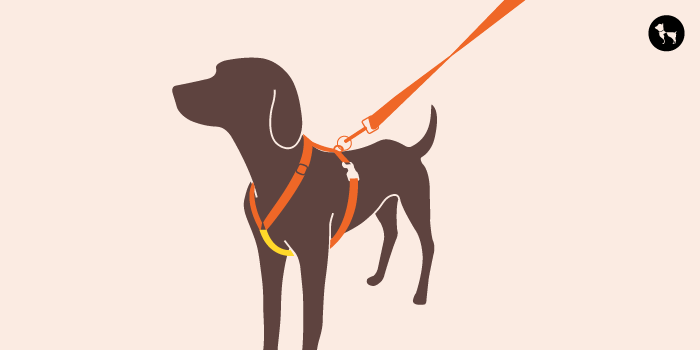Table of Contents
- Introduction to Dog Harnesses
- Different Types of Dog Harnesses
- Benefits of Using a Dog Harness
- How to Choose the Right Harness
- Training Your Dog to Use a Harness
- Common Mistakes to Avoid
- Safety Tips for Using Dog Harnesses
- Final Thoughts
Introduction to Dog Harnesses
Dog harnesses have become a popular alternative to traditional collars, offering many benefits that make walking and controlling dogs more manageable for pet owners. Unlike collars, which can cause strain on a dog’s neck, a harness distributes pressure more evenly across the body, significantly reducing the risk of injury. This design makes walks more comfortable for both the owner and the pet.
The growing popularity of harnesses is based on their ability to offer better control, which is particularly useful for training. Many pet owners have also reported that harnesses help to minimize pulling behavior, making walks smoother and less stressful. As more people adopt dogs and seek better ways to manage them, the need for reliable and effective harnesses continues to rise.
Different Types of Dog Harnesses
- Back-Clip Harnesses: These harnesses have a leash attachment on the back. They are suitable for small to medium-sized dogs that do not pull excessively. Back-clip harnesses are popular because they are easy to put on and comfortable for the dog.
- Front-Clip Harnesses: Designed for dogs that pull on the leash, front-clip harnesses offer better control by redirecting the dog’s motion toward you. This type of harness is especially beneficial for training dogs to learn to walk on a leash.
- Dual-Clip Harnesses: Versatile, flexible, dual-clip harnesses feature front and back clips. This design allows pet owners to switch between the two clips based on the situation, making them an excellent all-around choice for various training and walking needs.
- Step-In Harnesses: Ideal for dogs that dislike having objects placed over their heads, step-in harnesses are easy to put on. The dog simply steps into the harness, which is secured around them, making it a quick and hassle-free option.
Benefits of Using a Dog Harness
The benefits of using a dog harness extend beyond comfort and safety. For those looking to find the perfect harness, platforms like joyride harness provide various options tailored to meet different needs and preferences. One significant advantage is that harnesses distribute pressure more evenly across a dog’s body, reducing the risk of throat injuries common with traditional collars. Harnesses offer better control, making managing more extensive or energetic dogs easier.
Another essential benefit is the reduced risk of escape. H harnesses provide a more secure fit than collars, which can sometimes slip off or be wriggled out. This added security is particularly beneficial when walking dogs in busy areas or unfamiliar environments, offering peace of mind to pet owners.
How to Choose the Right Harness
Choosing the correct harness for your dog involves several important considerations. Firstly, size is crucial. To ensure a proper fit, measure your dog’s chest and neck; a well-fitted harness should be snug but not too tight. Secondly, the material of the harness should be both durable and comfortable. Popular materials include nylon and leather, with each offering unique benefits.
Additionally, adjustability plays a significant role in achieving a custom fit. Search for harnesses that have adjustable straps which can be easily adjusted as your dog’s size or weight changes. Lastly, consider the type of clips on the harness. Different clips offer varying levels of control, so matching the clip type to your dog’s walking behavior and training needs is essential.
Training Your Dog to Use a Harness
Training your dog to use a harness can be smooth and rewarding if approached correctly. Begin by allowing your dog to smell and investigate the harness so they can become acquainted with it. Gradually introduce the harness by placing it on your dog for short periods, allowing them to adjust. Rewarding with treats and praise can greatly improve the effectiveness of training. According to The American Kennel Club, harnesses are also an excellent tool for training dogs to walk correctly on a leash, as they can help mitigate pulling behavior without causing harm.
To further aid in the training process, utilize guidance from reputable sources like the ASPCA. Their specialized guidance can offer valuable perspectives and methods for hands-on training. Consistency and patience are key; with time and positive reinforcement, your dog will become comfortable and confident wearing a harness.
Common Mistakes to Avoid
- Improper Sizing: An ill-fitting harness can cause discomfort or even injury to your dog. Always measure accurately and choose a harness that fits snugly.
- Wrong Type of Harness: Selecting a harness that doesn’t suit your dog’s needs can lead to frustration. Consider your dog’s size, behavior, and specific requirements when choosing a harness.
- Lack of Adjustment: Dogs grow and change in size over time. Regularly check and adjust the harness to ensure a proper fit, as a loose or tight harness can be problematic.
Safety Tips for Using Dog Harnesses
Safety should always be a top priority when using a dog harness. Ensure the harness fits snugly but isn’t too tight, allowing for comfortable movement. Regularly inspect the harness for signs of wear and tear, replacing it if any damage is found. Never leavingIt a dog unattended while wearing a harness is also essential, as this can pose safety risks.
Consulting with a veterinarian can provide additional safety guidelines and personalized advice for those new to using harnesses. Veterinarians can offer valuable insights into the best practices for using harnesses, ensuring the safety and well-being of your pet.
Final Thoughts
Dog harnesses offer a safer and more comfortable alternative to traditional collars. Selecting the correct kind and making sure it fits well can enhance the experience of taking walks with your dog. Don’t forget, a properly fitting harness can greatly improve your pet’s walking experience. Choosing the correct harness and providing adequate training can greatly improve the connection between you and your pet, making each walk enjoyable.
Passionate content writer and savvy blog publisher, Aamir crafts compelling stories and insightful articles that captivate and inform. With a knack for blending creativity and strategy, they bring fresh perspectives to every piece. Dive into their world of words and discover content that resonates.





